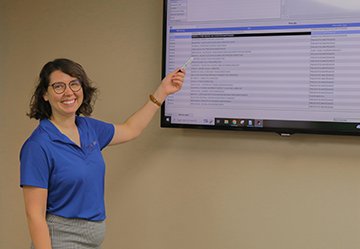Published: February 17, 2022 | Updated: October 01, 2025
Published: February 17, 2022 | Updated: October 01, 2025
The Evolving Landscape: Current Trends in CMMS Software
 As E. G. Balch noted, the future arises from both the unforeseen and the presently observable. This holds true for Computerized Maintenance Management Systems (CMMS). Like many aspects of business and technology, CMMS software experiences continuous evolution, adapting to shifting needs and technological advancements. This discussion examines current trends in CMMS software.
As E. G. Balch noted, the future arises from both the unforeseen and the presently observable. This holds true for Computerized Maintenance Management Systems (CMMS). Like many aspects of business and technology, CMMS software experiences continuous evolution, adapting to shifting needs and technological advancements. This discussion examines current trends in CMMS software.
Increased Adoption of CMMS Solutions
A growing number of organizations recognize the advantages offered by CMMS software. Despite the availability of numerous systems, many still manage maintenance through manual methods like spreadsheets or outdated programs. For CMMS providers, effectively demonstrating the benefits of a modern system to these untapped markets presents a significant opportunity. Highlighting how diverse entities, from large industrial plants to smaller organizations such as libraries and schools, can leverage CMMS for asset tracking, inventory control, maintenance scheduling, and even human resources and vendor management is crucial.
The Ascent of Cloud-Based CMMS
Accessibility has become paramount for users. The demand to interact with a CMMS from any location drives the increasing popularity of cloud-based solutions. Many CMMS companies now emphasize the advantages of the cloud, assuring businesses of data security and ease of access.
Integration with Automated Systems
Building upon the advancements in artificial intelligence, the capability for equipment to monitor its own condition is gaining traction. As more of these self-regulating systems emerge, CMMS platforms must offer seamless integration. This allows for a collaborative environment where human oversight complements automated monitoring.
Continuous Value Addition
While significant version updates are welcome, the ongoing introduction of new features sustains the relevance of an existing CMMS. Maintaining communication with customers proves vital for CMMS companies to understand evolving industry needs. By identifying features with broad applicability across various sectors or by offering tailored solutions, a CMMS can continue to provide value. Scalability also remains key. A CMMS must accommodate the varying needs of small businesses and large enterprises alike, adapting as these organizations expand.
Discover how streamlined maintenance processes can elevate production. Learn more.
The Necessity of Mobile Accessibility
Mobile adaptability is no longer a fleeting trend but a fundamental expectation. Software and applications designed for smartphones and tablets are essential. The ongoing task for CMMS is to enhance mobile functionality, providing users with comprehensive access to features and functions on the go.
With increasing global business operations, CMMS software that supports local languages offers a clear advantage to all stakeholders involved.
 Prioritizing User Experience and Training
Prioritizing User Experience and Training
The pursuit of innovation should not come at the expense of usability. Building upon proven designs, rather than opting for complete overhauls, often serves users better. A CMMS should maintain an intuitive interface, logical organization, and straightforward navigation. For both new and existing clients, effective training remains paramount. This includes initial onboarding, updates on new features, and guidance on maximizing the CMMS's potential.
The Enduring Importance of Support
Exceptional customer support should be a constant principle, not a temporary focus. Unfortunately, a decline in personalized customer interaction has been observed across industries. The implementation of automated systems can sometimes detract from the human element. When assistance is needed, prompt and effective issue resolution is critical. Dissatisfaction often stems from a lack of proactive support before a sale or inadequate assistance after a purchase. Businesses that fail to communicate with potential customers or neglect post-sale support risk losing not only current clients but also future referrals due to negative word-of-mouth. For CMMS companies, providing reliable support for new versions, features, and general inquiries is essential for maintaining customer satisfaction and loyalty.
Integration with the Internet of Things (IoT)
The integration of CMMS with IoT represents a significant shift in maintenance practices.
IoT devices and sensors gather real-time data on equipment performance and conditions. This data feeds into the CMMS, enabling a more proactive approach to maintenance. For example, sensors may monitor vibration, temperature, or pressure, and trigger automated work orders within the CMMS when deviations from normal parameters occur. This integration allows for:
- Enhanced asset visibility.
- Improved diagnostic capabilities.
- Greater accuracy in predicting maintenance needs.
This ultimately minimizes downtime and extends asset lifespan.
The Role of Artificial Intelligence
Artificial intelligence (AI) holds immense potential to transform CMMS operations. By analyzing large datasets, AI algorithms can identify trends, predict failures with greater accuracy, and automate various tasks. AI can:
- Enhance predictive maintenance by learning from historical data and sensor inputs to forecast when equipment failures are likely to occur.
- Automate work order dispatch and prioritization, ensuring that the right technician is assigned to the most critical task.
- Optimize inventory management by predicting spare part needs and automating procurement processes.
- Provide insights through advanced analytics, helping maintenance managers make data-driven decisions.
The incorporation of AI into CMMS leads to increased efficiency, reduced costs, and improved asset performance.
The dynamic nature of technology and business means that CMMS software will continue to evolve. As organizations evaluate new systems or assess their current ones, considering the alignment with prevailing software and industry trends is a vital step in ensuring long-term success. Contact Mapcon Technologies at 800-922-4336 to explore how these trends are integrated into their solutions.
FAQs
What are the current trends in CMMS software?
Trends include cloud adoption, mobile access, IoT integration, AI-driven analytics, and multilingual capabilities.
Why is cloud-based CMMS becoming popular?
Cloud solutions allow maintenance teams to access data securely from anywhere, improving flexibility and collaboration.
How does IoT integration enhance CMMS functionality?
IoT sensors provide real-time equipment data, enabling predictive maintenance and automated work order creation.
What role does AI play in modern CMMS systems?
AI analyzes historical and sensor data to predict failures, optimize work order dispatch, and improve inventory management.
Why is mobile accessibility important for CMMS users?
Mobile-friendly software allows technicians and managers to access work orders, inventory, and updates while on the go.
How does MAPCON support clients in adopting current CMMS trends?
Clients can access MAPCON’s technical support team for assistance with integrating cloud features, IoT monitoring, AI tools, and mobile access into their existing maintenance systems.
MAPCON CMMS software empowers you to plan and execute PM tasks flawlessly, thanks to its wealth of features and customizable options. Want to see it for yourself? Click the button below to get your FREE 30-day trial of MAPCON!
Try It FREE!